Search the Special Collections and Archives Portal
Search Results
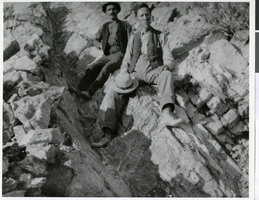
Photograph of Ed Von Tobel, Sr. exploring a mining claim, Las Vegas Region, circa 1900s
Date
1900 to 1909
Archival Collection
Description
Ed Von Tobel, Sr. and (possibly) Tony Felix on an exploring trip for mining claims in mountains surrounding Las Vegas. Physical object has an insert containing additional biographical information.
Image
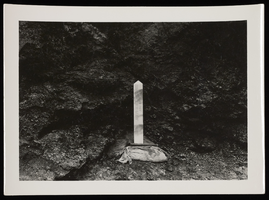
Photograph of miner's monument, Kingman Wash (Ariz.), circa 1932
Date
1931 to 1933
Archival Collection
Description
Miner's monument for Joseph Herber Richards at Kingman Wash. He died June 18, 1917 and had previously owned the mine at Sheep Mountain. Note reads: "He died in Kingman Wash, 300 yards from Colorado River. His miners pick is imbedded in the cement." - W. A. Davis, April 1992.
Image
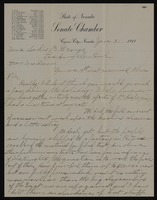
Correspondence, Levi Syphus to Sadie George
Date
1911-01-31
Archival Collection
Description
This folder is from the "Correspondence" file of the Sadie and Hampton George Papers (MS-00434)
Text
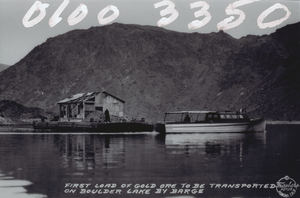
Film transparency of postcard showing a boat transporting gold ore on Lake Mead, circa late 1930s
Date
1935 to 1939
Archival Collection
Description
An image of a mining building and a boat on Lake Mead. Gold ore claims were made near the northern shores of Lake Mead in the late 1930s, after the completion of Hoover Dam. Shipments of ore were towed down Lake Mead by barge for railroad transport. Text on bottom of image reads: "First load of gold ore to be transported on Boulder Lake by barge." Note: Boulder Dam was officially renamed Hoover Dam in 1947.
Image
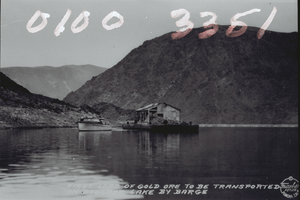
Film transparency of a postcard showing a boat transporting gold ore on Lake Mead, circa late 1930s
Date
1935 to 1939
Archival Collection
Description
An image of a mining building and a boat on Lake Mead. Gold ore claims were made near the northern shores of Lake Mead in the late 1930s, after the completion of Hoover Dam. Shipments of ore were towed down Lake Mead by barge for railroad transport. Text on bottom of image reads: "First load of gold ore to be transported on Boulder Lake by barge." Note: Boulder Dam was officially renamed Hoover Dam in 1947.
Image
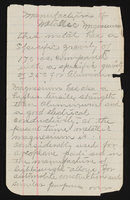
Information on the composition of magnesite
Date
1874 to 1944
Archival Collection
Description
This folder is from "Maps and Assorted Documents" file of the Sadie and Hampton George Papers (MS-00434)
Text
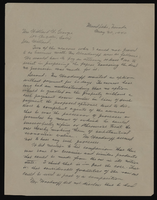
Correspondence, Levi Syphus to Willard George
Date
1940-05-20
Archival Collection
Description
This folder is from the "Correspondence" file of the Sadie and Hampton George Papers (MS-00434)
Text
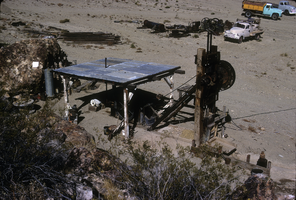
Slide of the old stamp mill, circa 1950s
Date
1950 to 1959
Archival Collection
Description
The old stamp mill, location unknown. A stamp mill (or stamp battery or stamping mill) is a type of mill machine that crushes material by pounding rather than grinding, either for further processing or for extraction of metallic ores. Breaking material down is a type of unit operation. A stamp mill consists of a set of heavy steel (iron-shod wood in some cases) stamps, loosely held vertically in a frame, in which the stamps can slide up and down. They are lifted by cams on a horizontal rotating shaft. On modern mills, the cam is arranged to lift the stamp from the side, so that it causes the stamp to rotate. This evens the wear on the shoe at the foot of the stamp. As the cam moves from under the stamp, the stamp falls onto the ore below, crushing the rock, and the lifting process is repeated at the next pass of the cam. Each one frame and stamp set is sometimes called a "battery" or, confusingly, a "stamp" and mills are sometimes categorized by how many stamps they have, i.e. a "10 stamp mill" has 10 sets. They usually are arranged linearly, but when a mill is enlarged, a new line of them may be constructed rather than extending the line. Abandoned mill sites (as documented by industrial archaeologists) will usually have linear rows of foundation sets as their most prominent visible feature as the overall apparatus can exceed 20 feet in height, requiring large foundations. Stamps are usually arranged in sets of five. Some ore processing applications used large quantities of water so some stamp mills are located near natural or artificial bodies of water. For example, the Redridge Steel Dam was built to supply stamp mills with process water.
Image
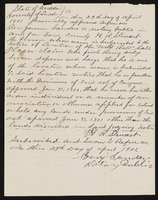
Notarized placer claim
Date
1901-04-29
Archival Collection
Description
This folder is from "Legal Records" file of the Sadie and Hampton George Papers (MS-00434)
Text

Correspondence, E.H. Syphus to H.E. George
Date
1902-01-26
Archival Collection
Description
This folder is from the "Correspondence" file of the Sadie and Hampton George Papers (MS-00434)
Text
Pagination
Refine my results
Content Type
Creator or Contributor
Subject
Archival Collection
Digital Project
Resource Type
Material Type
Place
Language
Records Classification
